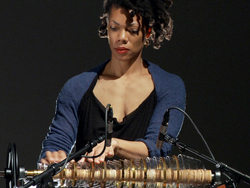by Mike Telin

On Sunday, December 15 beginning at 7:30 pm, CMA Concerts at Transformer Station presents Camille Norment, glass armonica, who will be joined by her Trio colleagues Håvard Skaset, electric guitar and Vegar Vårdal, hardingfele (Norwegian fiddle).
Originally from the Washington D.C. area of Maryland, Norment says her expansive list of artistic interests began to be formed at the University of Michigan where she earned her bachelor”s in comparative literature and art history. Her website lists Objects/Installations, Photo/Video, Sonic/Performance and Text as areas of interest. “I do love writing and all of these elements are very closely knit for me.” And she believes that live performance is not only about sitting back and having a listening experience but contemplating and being receptive to an opening-up of ideas and coming out with questions.
Camille Norment: It’s going to be a very special concert so I had to smile when I saw that you were writing about it from a classical music perspective.
Mike Telin: Well, the definitions of classical music have been blurred and I think it’s a very exciting time for classical music.
CN: Yes it is. When you mention blurring the lines, there are certainly classical elements in our music and in our performances with many strong references to one work in particular which is Arvo Pärt’s Fratres. That very much inspired the title track of our first album that we released in the fall entitled Toll. But when you hear it, either on recording or live, I think you’d have to really listen hard to recognize any similarities at all beyond the beginning.
MT: Are the pieces on Sunday’s concert composed or will they be improvisations around a theme?
CN: There are composed pieces, and there are parts that are improvised. We work in this area between improvisation and composition. But yes, most of our pieces are composed and most of them are on our album.
MT: I need to ask: how did you become interested in the glass armonica?
CN: It is a funny story in a way but a very precise experience. I mentioned Arvo Pärt’s Fratres. I listened to it a lot in the 90’s alongside this ambient and early noise music and techno but since then I hadn’t listened to it much at all. Then a couple of years ago it came up on my iTunes playlist just by chance and while it was playing I heard it in a completely different way. Suddenly there was a very high pitched sound, the kind produced by rubbing your finger around the rim of a wine glass. When it finished I thought it was amazing and the only way I could relive that experience was to recreate the music.
While researching how to prevent the wine glasses from falling over when you play them I came across this weird instrument I had never heard of before called the glass armonica. When reading about the instrument I thought, this has my name all over it. And it can produce the exact sound I was looking for. The history of the instrument is absolutely amazing — its relationship to psychology via Franz Mesmer, and it had been invented by Benjamin Franklin in 1761, which in itself I thought was fascinating. So yes, I immediately fell in love with it.
MT: I’ve enjoyed listening to your music very much and I am completely fascinated by the juxtaposition between the experimental and the folk elements.
CN: That is interesting to me as well. I’ve been in Oslo for eight years but culturally I’m still an outsider, which means there are certain things that I still view from a distance. And I think the relationship between the hardingfele (Norwegian fiddle) and the national identity in Norway is very strong. And it carries with it a lot of emotions having been associated with new movements of nationalism, both strongly for and against. But in any case it’s impossible to even mention the instrument to most Norwegians that I know without it bringing with it a bag full of connotations.
So I felt completely liberated to just focus on the incredibly magical and haunting sound that the instrument produces, and I thought, why not put it alongside a glass armonica? My interest in the instrument is purely sonic because of the overtones, which is why I’m not using a violin but rather the hardingfele.
MT: What first attracted you to the Norwegian music scene?
CN: Since the 90’s I had been familiar with the Norwegian recording artists who were playing what was then called ambient music. I wouldn’t say early experimental because that was usually happening in the 60s but sort of this revival of experimentation via the access to digital media. And so much of that music was coming out of Norway. At that point I also had a partner who was Norwegian but I never thought it would be such a strong connection in my future.
MT: Is there anything else you would like our readers to know about your music or the concert?
CN: It is experimental music and my intention is not to offer something that people already know. My goal is certainly to push limits and to create something new. And with that there always come challenges — but I welcome them with open arms.
Also I love what I do and the reception that the trio has received has been quite overwhelming. We have only existed for two years, so coming from scratch and assembling three very different instruments, and creating what we have, I’m very proud of it. I’m still very curious and there’s a lot of space left to explore — and that’s a positive thing.
Published on ClevelandClassical.com December 10, 2013
Click here for a printable version of this article.



